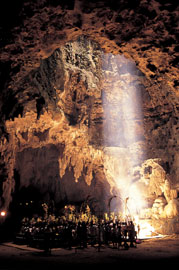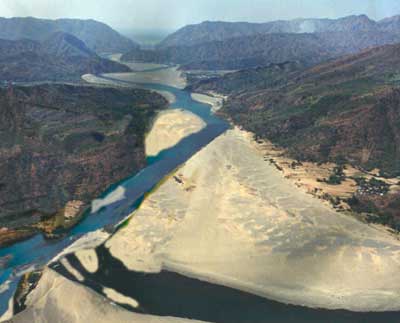
Callao Caves

Cagayan River
| |
Tuguegarao, Cagayan Valley
Ecotourism Adventure Haven
Capital: Tuguegarao
No. of Towns: 29
Land Area: 9002.7 sq km
Telephone Area Code: 078
Zip Code: 3500
A lush valley at the northeast most tip of the Philippines, Cagayan is a stark surprise of verdant Sierra Madre and Cordillera mountains to the longest and widest river in the Philippines, the Cagayan River, from the lovely beaches of coastal towns to luxuriant lands heavy with golden plants to the infinite bosom of the Pacific Ocean.
Cagayan is the Regional Seat of the Cagayan Valley Region. Tuguegarao, the capital town is the seat of commerce and trade and center for learning. The province has the largest marine fishing grounds and 73 percent of the regions potential fishpond area.
Known as the spelunkers, trekkers and gamefishers paradise rolled into one, Cagayan provides a never-ending adventured with ecotourism in the forefront of its offerring. Both foreign and local tourists continue to explore its caves, engage in gamefishing expeditions, trek its mighty mountains and retreat to its centuries old churches.
Brief History
Cagayan is undoubtedly one of the richest archeological sites in the Philippines. Excavations by the National Museum and field researches of the Cagayan Museum have unraveled vast archaeological findings, including artifacts dating back to the Paleolithic age. It is the presence of such discoveries which gives evolution of the Cagayano.
The whole northeastern part of the big island of Luzon, plus some small islands on the Balintang Channel, was once upon a time a single political unit known as "La Provincia de Cagayan". Protected on its eastern side by the Sierra Madre, and on the north by a chain of sentinel islets called by the Babunanes, this is where the forefathers of Cagayan chose to settle when they came from beyond these shores either on land-bridges or in frail "birays" which other people prefer to call "binidays".
Archeologists say that the earliest man in the Philippines probably lived in Cagayan thousands of years ago. In their search for this guava man, a likely contemporary of the Java Man, excavators are turning earth downside up, but unless and until they can convince the Cagayanos with evidence beyond scientific doubt , it cannot be pointed to that guava man was the ancestor or precursor on terra Cagayana.
From available evidence, the first man hereabout was the Atta, a short dark-skinned nomad who was at home nowhere until the Indo-Malays came from somewhere, in the jungles where root and fruit helped him survive. Indigenous tribes still live in the Cagayan, although their livelihood is or has been threatened by illegal logging. Recently some indigenous tribes got 1 million hectares ancestral land back.
Sometime between 200 B.C. and 300 C.C. when mass immigrations into Cagayan took place, the Indo-Malays who eventually came to be known as Ybanag, Ytawit, Yogad, Gaddang, Yraya, and Malaweg, settled in the Cagayan Valley. Though they were known by different handles and labels, they were really one ethnic family, albeit for better or for worse, for richer or for poorer, and for any number and kind of excuse, they opted for a parting of ways when they arrived at points where the traits forked out here or there.
Evidence of their original oneness are the similarities in their features, the common elements in their languages, beliefs and practice, and the unchanging reference among all of them to the same legendary heroes, Biwag and Malana.
These were the people whom the Spaniards found in villages on the sea-coast and along the rivers all over the valley. These villages followed modus vivendi among themselves described in the unom of "maguray y maporay, mesipo y masippo, mawawan y karwan".
Rightly judging these people to be of a single racial stock, the Spaniards decided to make the Ybanag tongue their lingua franca, civilly and ecclesiastically enforced, and they lumped them together under the common denominator of "Cagayanos". In later years, the Cagayanos of yesterday became the Cagayanos of today.
When the Spaniards came to Cagayan in the second half of the sixteenth century, they discovered that the natives had long been in contact with Chinese, the Indians and the Japanese. Attesting to this are the artifacts being unearthed today which are definitely dated to pre-Hispanic times, many linguistic elements present in the speed of the people which are clearly of Chinese, Indian or Japanese origin, and the presence of a Japanese fleet at the mouth of Cagayan River in 1581. The people in that fleet must have been traders who had come with no designs of conquest, for the natives did not resent their coming to their land, although the Spaniards thought differently. Like the Portuguese, like Limahong, like the Dutch and British of later years, Tayfusu and his men had no business encroaching on al land which had already been claimed in a solemn act for the King of Spain. Be that as it may, the fact remains that before the Spaniards came to Cagayan the natives had already been in contact with foreigners who enriched their life and culture with encrustations from their own.
That the early inhabitants of Cagayan lived in villages which were properly organized and which maintained trade and security relations with one another give proof of the kind of culture which existed among them already at that time. The stock which they had brought from the lands of their provenance or domesticated those that they found in the new homeland; they wove cloth form plant fibers and kapok thread; they fashioned household and farm implements from metal; they cooked their food in pots and vessels made of clay.
LANGUAGE/DIALECT
Languages in the province are Ibanag, Itawit, Malaweg and Ilocano. Other ethnic groups that migrated to the province speak their own dialects. People in places where literacy is high speak and understand English and Pilipino.
MAJOR INDUSTRIES
The province of Cagayan is blessed with rich fertil valleys for agriculture and vast natural resources. The mountain ranges with its extensive forests are rich sources of forest products. On the coastal part of the province are great bodies of water such as the Balintang Channel and the Pacific Ocean which could support a thriving fishing industry.
The province has already earned the distinction of being a major food supplier away to the rest of the country, especially in grains and legumes. With the maximum utilization of this resource, the province could become a major supplier of fruits and vegetables, as well as other commodities particularly those with high linkages to industries like sugar cane, coconut, and tobacco, among other commercial crops.
Getting there and away:
By Air...
Philippine Airlines
55 minutes by air
Flies Mondays, Wednesdays, and Saturdays
Some Contents from:http://www.wowphilippines.com.ph/
|
